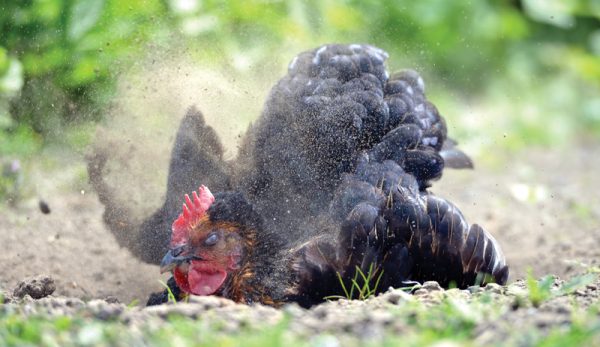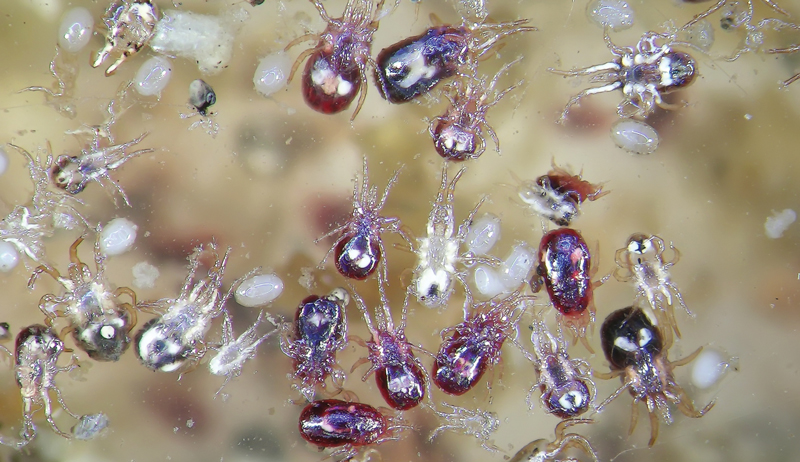
Nobody likes finding creepy crawlies such as lice, mites or fleas on their chickens. It can quickly turn a chicken hug into your worst nightmare! These ectoparasites can feed on the blood of their host (for example, your chicken).
But other ectoparasites can also feed on chicken feathers, skin and even scales.
Moreover, severe infestations can lead to poor health and welfare. Therefore, even though they are small and may not seem to bother your chickens at the moment, it’s important to regularly check and control for ectoparasites before they get out of hand.
In this column, we’ll provide information on how to get rid of some of the most common ectoparasites of backyard chickens. Aand, more importantly, we’ll cover preventing them from invading your coop in the first place.
Hosting Duties
Your goal is to use the best tools and strategies against your specific ectoparasite. This way, you’ll ensure your time and efforts don’t go to waste.
In order to do this, figure out what ectoparasite you’re dealing with and learn more about them. For example, learning about their hiding spots and their favorite feeding locations can help you create an elimination plan that is more effective.
There are many great books, articles and websites available to help you identify chicken ectoparasites. But identifying ectoparasites can be tricky.
Luckily, there are extension professionals with a focus on veterinary entomology available to help you across the United States and Canada.
To see if there is one in your region, check out the Veterinary Entomology website, a pest management and education resource for animal owners and producers, extension agents, veterinarians, wildlife professionals and the public. Once you have identified the culprit, you can begin to answer important questions, including the following.
Read more: Internal parasites? Here’s how to keep your flock’s insides clear.
On Host or Off?
Ectoparasites by definition live on the surface of a host—in this case a chicken. However, not all critters read the rulebook.
Interestingly, some go rogue and hide in the chicken coop after feeding on your chicken. These are known as “off-host” ectoparasites. It’s sneaky, right?
Others can be sneakier. Ectoparasites such as the chicken mite will hide in the coop during the day and then climb on your chicken at night for a late-night snack.
Your chicken may seem ectoparasite-free. But really the ectoparasites may just be hiding in crevices or cracks and only come out at night. This means that ectoparasite monitoring and control goes beyond your chicken.
You also need to check and regularly clean your coop and yard. Keep in mind that crevices and cracks are their favorite hiding spots, as they don’t like to be out in the open. Examples of off-host ectoparasites include red mites and bed bugs.
(Yep, the same bugs that can be found on our beds can also be found on your chickens!)
Chicken Parts
Ectoparasites that live and feed on chickens all their lives (a/k/a “on-host” ectoparasites) may sound simple to find. However, they can also be difficult to notice.
In fact, some lice and mites can be found on specific regions of the body, such as the head, wing, body or tail exclusively. Therefore, when you are examining your birds, examine them thoroughly from head to tail. Just checking the head or tail can be misleading.
Examples of on-host ectoparasites include northern fowl mites and scaly leg mites.
Severe northern fowl mite infestations can cause anemia, decrease egg production and may even cause death in severe cases. Moreover, mite bites can be irritating and itchy to humans.
In poultry, scaly leg mites go underneath scales located at the feet and, at times, around the nostrils. The mites can cause so much damage that the feet and shanks begin to look flaky, powdery and, in severe cases, deformed.
If too severe, scaly leg mite infestations can cause painful injuries and deformations. Therefore, as mentioned before, it is important to monitor and control for ectoparasites before they become too severe. If you suspect your bird has scaly leg mites, reach out to your veterinarian (who treats poultry) or to a diagnostic laboratory
Examining Your Birds
While using examination gloves, check the head, wing, vent, breast, thigh and tail regions by spreading the feathers until you can see the skin where lice and mites or their eggs can be observed.
Check all of your birds. It’s common for only a couple of birds to be carriers as opposed to the entire flock.
If you find infected birds, make sure to separate them from the rest of the flock to keep the rest of the birds healthy.
Coop Cleaning
As mentioned previously, just getting rid of ectoparasites that are on your bird is sometimes not enough. Ectoparasites such as red chicken mites, fowl ticks and bed bugs may hide in cracks, crevices and roosts during the day and feed at night.
Additionally, while adult sticktight fleas typically embed in the face, wattle or comb, sticktight larvae can live in poultry bedding. As if things were not complicated enough!
Therefore, it’s a good idea to regularly check and clean your coop and yard for ectoparasites especially the areas that your chickens like to hang out in.
Check for lice twice a month at least. And fill in cracks and crevices. These are both good interventions to keep in mind.
Read more: Here’s the dirt on diatomaceous earth.
Death by Desiccation
As you have probably noticed already, chickens love to dust-bathe. Well, it turns out that dust-bathing in dirt or sandlike material is great for ectoparasite control.
According to research from the University of California Riverside, providing a kiddie pool, cat litter box or similar plastic container, with a 1:4 ratio of food-grade diatomaceous earth to play sand can help fight lice and mites infestations.
When lice and mites come in contact with diatomaceous earth, it’s thought that they die from desiccation as the oils in the outer shell become absorbed by the diatomaceous earth. Because diatomaceous earth needs to come into direct contact with the ectoparasite, it’s important to use appropriate material such as sand in combination with diatomaceous earth.
Diatomaceous earth by itself or with hay may not work as effectively if at all. Please note that when mixing the diatomaceous earth with play sand, you should follow the handling instructions carefully and wear a dust mask. Diatomaceous earth can be irritating to humans.
Essential Oils
There is a growing body of literature regarding use of essential oils for ectoparasite control. While some, such as cade and thyme, seem promising for the control of northern fowl mites, further studies are needed.
At the moment, results are inconsistent. Most likely, this is due to differences in plant variety, growing conditions and processing among other things. In addition, we need more studies that test at what dose they are safe to use on chickens.
Therefore, stay cautious when trying out different essential oils. Remember that pure essential oils need to be diluted in carrier oils such as sunflower oil before applying to birds directly.
Prevention Pointers
Unfortunately, there is no silver bullet when it comes to ectoparasite control. However, establishing a biosecurity plan, which is a set of management practices designed to prevent the spread of disease or ectoparasites onto and between premises, can go a long way.
Here are some good tips to keep in mind:
- Certain ectoparasites such as the northern fowl mite can infest domestic as well as wild birds and other wildlife. Therefore, it’s important to prevent your chickens from interacting with wild birds, their nests and rodents. Try to use netting and reflective material around your coop to keep them at a distance.
- Quarantine and check new birds for ectoparasites. This will prevent new birds from introducing bugs to your flock and coop.
- Avoid visiting other coops and then entering your own coop. But if it’s unavoidable, you should change into clean clothes before entering your coop and wash your old clothes with hot water and dry them with high heat. Similarly, before placing items into your coop, you should inspect and clean them thoroughly.
While biosecurity can help reduce the risk of ectoparasites invading your coop, you won’t eliminate risk completely. You really need to use a combination of husbandry and biosecurity practices to prevent the spread of ectoparasites.
Fortunately, the same biosecurity practices you use to help prevent the spread of ectoparasites can also help prevent spread of disease.
This article, which appeared in the May/June 2020 issue of Chickens magazine, was written by Myrna Cadena (a Ph.D. student in the Animal Biology Graduate Group at UC Davis) and Dr. Maurice Pitesky from the UC Davis School of Veterinary Medicine-Cooperative Extension.





